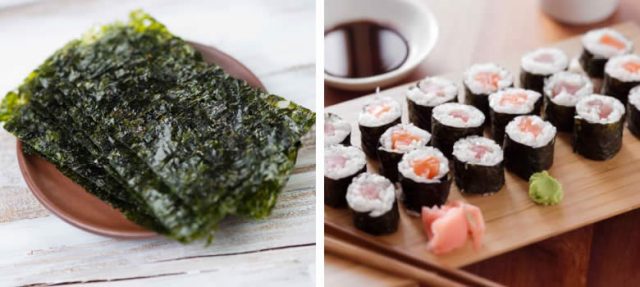Seaweeds, a form of sea vegetable and edible algae, are extremely common in Japanese cuisine and are used everywhere from soups, salads, sushi and even to add flavour to the dishes.
Seaweed boosts metabolism and is rich in antioxidants. It’s highly recommended to add seaweed into dietary plans since it improves heart health and lowers blood pressure.
Japanese people have known the powerful advantages of seaweed for centuries and incorporate it in almost every dish they have.
Chances are, if you’ve been to a Japanese restaurant, you’ve probably encountered nori wrapped around your sushi, wakame in your miso soup, maybe a small side dish of su-no-mono (cold dish in vinegar) with cucumbers and mozuku, and the dashi (broth) in your soup may have been taken from kombu.
There are 7 common types of Japanese seaweed that have been included in the Japanese diet for centuries due to its health benefits and unique umami taste.
NORI

Nori is paper-thin and dark green in colour. It is often used for sushi in general. Nori is widely available as a large sheet called yaki nori which is basically dried and then grilled.
For added effect, you can sprinkle it anywhere on your rice, soup or even salads.
KOMBU KELP
Kombu, also known as Kelp, is a primary ingredient in Japanese soup broths. Japanese kelp is dark green and has a thick leather-like texture. Almost 20 species of this seaweed exist and 12 such variants thrive on Hokkaido’s coastline. The Rishri Kombu is typically considered to be the secret ingredient for the best ramen recipe in Japan.
WAKAME
Wakame grows in mineral-rich arctic currents and tastes a bit salty. It has a sweet flavour with unique tenderness and is ideal for miso soup, summer salads and as a side dish.
More Recommendations: In Pics: 5 Artisanal Indian Food Brands That Are Loved Globally
HIJIKI
Hijiki grows on the coastline of China, Japan and Korea. It is a common belief in Japan that this seaweed can give black, lustrous hair. This edible marine algae appears similar to dried black tea leaves and has a subtle earthy, nutty taste.
Hijiki needs to be rehydrated before cooking with sugar, soy sauce, and several other seasonings. It is often simmered and then served with fried tofu and carrots as a simple salad.
MOZUKU
Mozuku, edible algae that are farmed by hand, is similar to turmeric, tofu and goya.
Mozuku is Japan’s secret ingredient of longevity.
UMI BUDOU
Umi budou is harvested in the waters of Okinawa Prefecture and literally translates to “sea grapes”, as its tiny spheres resemble grapes. Umi bodou is considered a local delicacy in Okinawa and is occasionally referred to as green caviar. In the mouth, you feel the little grapes bursting in your mouth!
AONORI
Aonori is a dried green laver that is used to garnish savoury dishes such as takoyaki (octopus balls), yakisoba (fried noodles) and okonomiyaki (savoury pancakes). Salt and Aonori (norishio) is an extremely popular Asian snack flavour sold in Japan.
Image Credits: Google Images
Feature Image designed by Saudamini Seth
Sources: Japan Taste, Honest Food Talks, Japanese Food Guide
Find the blogger: @Drishti Shroff
This post is tagged under: Japanese Cuisine, Sushi, Salad, Soup, Nori, Algae, Edible Algae, Seaweed, Wakame, Umo Bodou, Mozuku, Hijiki, Kombu Kelp, Aonori, Japanese Seaweed, Food, Japanese, Japanese food
Disclaimer: We do not hold any right, copyright over any of the images used, these have been taken from Google. In case of credits or removal, the owner may kindly mail us.